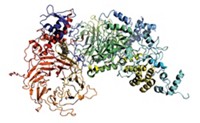Advertisement
Grab your lab coat. Let's get started
Welcome!
Welcome!
Create an account below to get 6 C&EN articles per month, receive newsletters and more - all free.
It seems this is your first time logging in online. Please enter the following information to continue.
As an ACS member you automatically get access to this site. All we need is few more details to create your reading experience.
Not you? Sign in with a different account.
Not you? Sign in with a different account.
ERROR 1
ERROR 1
ERROR 2
ERROR 2
ERROR 2
ERROR 2
ERROR 2
Password and Confirm password must match.
If you have an ACS member number, please enter it here so we can link this account to your membership. (optional)
ERROR 2
ACS values your privacy. By submitting your information, you are gaining access to C&EN and subscribing to our weekly newsletter. We use the information you provide to make your reading experience better, and we will never sell your data to third party members.
Biological Chemistry
Gene-silencing RNAs get guidance
July 3, 2006
| A version of this story appeared in
Volume 84, Issue 27
An RNA guidance systemcan be used to target gene-silencing RNA molecules to specific cells, according to two independent reports. Delivering appropriate short interfering RNAs (siRNAs) is a potential therapeutic approach for killing cancer cells. In both studies, the researchers use ligand-binding RNA molecules called aptamers to pilot siRNA molecules to prostate cancer cells. The aptamers recognize a cell-surface receptor specific to prostate cancer. Bruce A. Sullenger and coworkers at Duke University Medical Center have shown that injecting chimeric aptamer-siRNA molecules into mouse tumors results in cell death and tumor shrinkage (Nat. Biotechnol., published online June 25). Matthew Levy, Andrew D. Ellington, and coworkers at the University of Texas, Austin, connect a different aptamer to siRNA via a streptavidin link (Nucl. Acids Res., published online June 1). In both cases, the RNA molecules enter only cells with the prostate-cancer-specific receptor on the surface. The siRNAs effectively silence their target genes in both cases. It remains to be seen whether either version of the aptamer-siRNA conjugates can be adapted for systemic delivery.




Join the conversation
Contact the reporter
Submit a Letter to the Editor for publication
Engage with us on Twitter